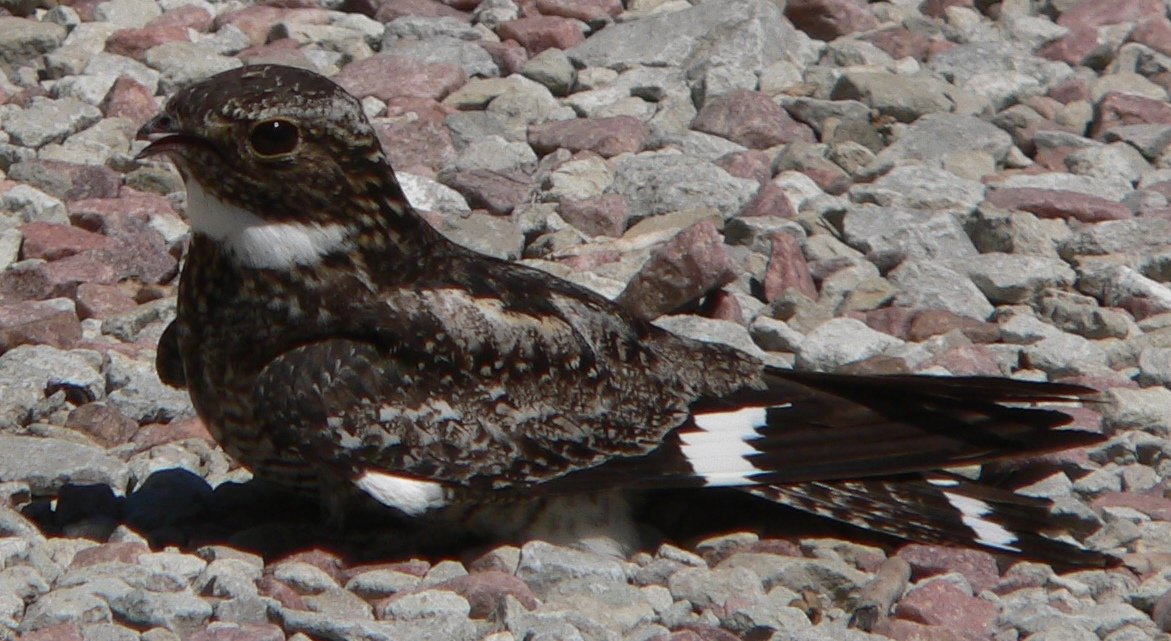Why Common Nighthawks Like Ball Games (and Other Intriguing Facts About These Fascinating Birds)
Source: Wikimedia Commons
by Maggie Van Dyke
COS president Edward Warden associates Common Nighthawks with White Sox games. “The evening games are my favorite because, even when the Sox are losing, I can look up to see nighthawks flying around the lights,” he said.
The stadium’s floodlights attract moths and other flying insects. These, in turn, draw insectivores like Common Nighthawks. The jay-sized brown and white birds are only in the Chicago area for a brief span each year, arriving in late May to early June to breed and nest. Then nighthawks follow their food supply south in mid to late August.
Like many migratory birds, Common Nighthawks are in decline. “We’re reasonably confident that the decrease in insect life across North America is a big contributing factor, but we don’t 100 percent know if that’s the reason,” Warden explained during a discussion with a group of interns with the University of Illinois Extension Master Naturalist Program.
Nighthawks are also somewhat of a mystery to scientists. “For a bird that’s called common, it’s a very poorly studied species,” Warden said.
To learn more about nighthawks and how to conserve the species in urban areas, COS launched the Chicago Nighthawk Project in 2022. The voluntary program recruits citizen scientists to find and count the birds and note their habitat preferences.
Volunteers don’t have to buy tickets to a professional ball game for a chance to spot Common Nighthawks catching insects mid-air. Warden recommends frequenting local parks that have outdoor ball fields with flood lights installed. Two examples in the city are Humboldt Park and Horner Park.
Other places to spot Nighthawks flying is over open areas near wetlands or woods, typically right before sunset or right after sunrise.
Besides frequenting outdoor ball games, Common Nighthawks have other interesting behaviors bound to endear them to bird lovers. Here are five intriguing facts:
Source: Wikimedia Commons
1) Nighthawks are not Hawks.
Despite the “hawk” in their name, Common Nighthawks are not related to hawks. Nighthawks belong to the nightjar family, which includes whip-poor-wills.
How did nighthawks get the “hawk” in their name? “The name originates from the term hawking,” Warden explained. “This is a type of hunting strategy that nighthawks use, which involves flying at high speed and capturing things in their mouths on the wing.”
2) Nighthawks have one of the longest migrations of any North American bird.
Common Nighthawks spend the winters in South America, primarily in Brazil but also in southern Columbia, Venezuela, and northern Argentina.
Come late spring, they migrate north, settling across North America to breed. Populations nest as far north as the Yukon, as far south as Mexico, and everywhere east and west between Maine and California.
All together, nighthawks fly 2,500 to 6,800 miles during each migratory journey.
3) Nighthawks rely on blending in to survive.
Common Nighthawks prefer to nest on the ground, typically in rocks, gravel, dirt, and grasslands. “Their boring dirt-brown coloring works well in their favor,” Warden said. It is very difficult for predators, including hawks, coyotes, and raccoons, to see them.
In Chicago and other urban areas, nighthawks can be found on flat gravel rooftops. “For a large portion of our history, we’ve covered roofs with gravel, especially on larger industrial buildings,” Warden said. “It’s called ballast roofing. And these gravel rooftops have proven to be a fantastic spot for nighthawks to lay their eggs.”
4) Nighthawks can hibernate for short periods of time.
“If conditions aren’t right—such as it’s too cold or there’s not enough food available—nighthawks can slow down their heart rate and enter a hibernation state for a short period of time,” Warden said.
This ability, known as torpor, is extremely rare in the bird world. The majority of birds capable of hibernation are in the nightjar family.
5) Nighthawks use distinct sounds to communicate.
One way to identify nighthawks is to listen for two distinct sounds that they make.
One is a “peent” sound, which nighthawks make to mark their territory. “It’s one bird indicating to another, ‘Hey, this is my space. Don’t encroach,’” Warden said. “It is also used to communicate with potential mates: ‘Hi, this is my space, please encroach.’”
The second sound is a loud boom that nighthawks make with their wings to attract mates. Nighthawks go into a fast descent, which forces air through their wings, causing that boom call. “You’ll only hear that during spring mating season,” Warden said. “Once you start getting into July and August, you’ll only hear the ‘peent’ calls.”


